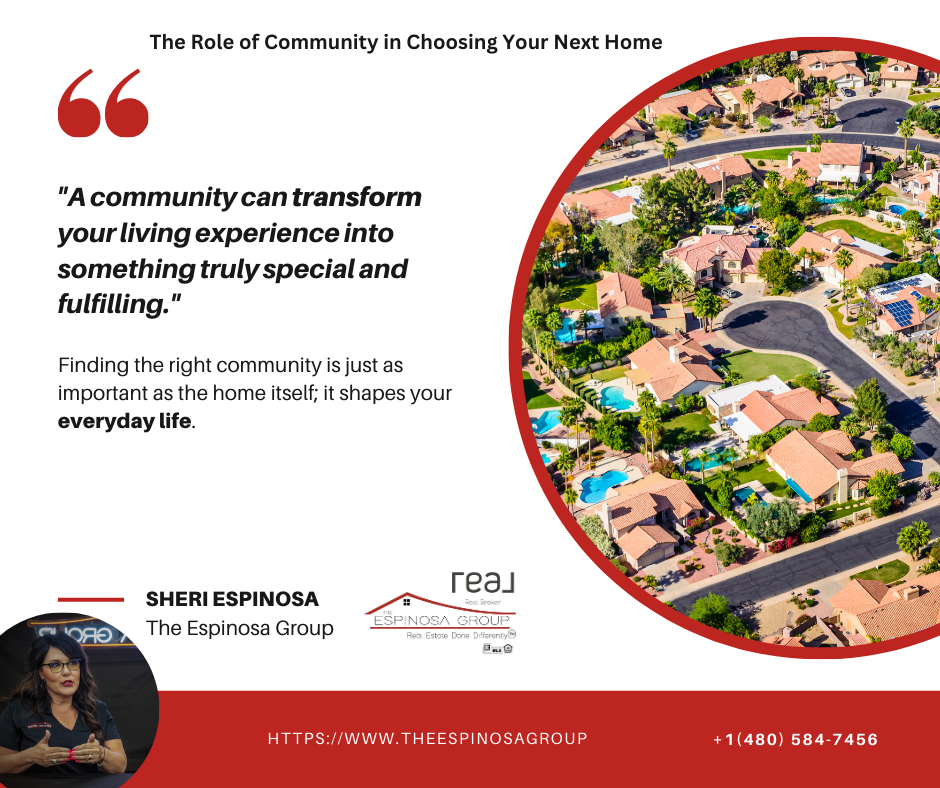The Role of Community in Choosing Your Next Home
When buying a home, it’s easy to focus on features like square footage, design, and price. However, a home is more than just the building—it’s the environment surrounding it that turns a house into a lifestyle. The community you choose plays a pivotal role in your overall happiness, convenience, and even the value of your investment. Here’s why the neighborhood culture, schools, and amenities should be top considerations when choosing your next home.
1. Neighborhood Culture: Finding Your Fit
Every community has its own vibe, and it’s important to find one that aligns with your lifestyle and values.
- Family-Oriented Areas: If you have kids or plan to, look for neighborhoods with family-friendly activities, parks, and events.
- Vibrant Nightlife: For younger professionals or couples, communities with trendy restaurants, bars, and social spaces might be a better match.
- Quiet Retreats: Some buyers prefer serene settings with a slower pace, ideal for retirees or those seeking relaxation.
- Diversity and Inclusion: Research the cultural diversity of the area to ensure it feels welcoming and aligned with your values.
Tip: Visit potential neighborhoods at different times of the day and week to gauge the atmosphere and interactions among neighbors.
2. Schools: A Long-Term Investment
Even if you don’t have school-aged children, local schools can impact your home’s value and future resale potential.
- Quality of Education: Research school ratings and performance data. High-performing schools are often a sign of a well-supported community.
- Proximity to Schools: Being close to schools can be a draw for families, making your property more appealing to future buyers.
- Extracurricular Programs: Schools that offer robust sports, arts, and academic programs can enhance the community feel.
Resources: Websites like GreatSchools.org or local district sites can provide valuable insights into school rankings and reviews.
3. Amenities: Convenience and Comfort
Amenities can greatly influence your day-to-day lifestyle and convenience.
- Shopping and Dining: Easy access to grocery stores, shopping centers, and restaurants makes everyday life more convenient.
- Healthcare Facilities: Proximity to hospitals, clinics, and pharmacies is important, especially for families or retirees.
- Recreation: Parks, gyms, walking trails, and community centers add value by promoting health and social connection.
- Transportation: Check for reliable public transit options, bike paths, or major road access if you need to commute.
Pro Tip: Look into future developments in the area that could add value, such as planned retail centers or infrastructure improvements.
4. Safety and Security: Peace of Mind
Feeling safe in your community is non-negotiable.
- Crime Rates: Research crime statistics in the area through public safety reports or online tools.
- Lighting and Infrastructure: Well-lit streets and maintained sidewalks contribute to a safer environment.
- Neighborhood Watch Programs: A strong sense of community involvement in safety measures is a positive sign.
5. Social Opportunities: Building Connections
The right community can provide you with more than a place to live—it can give you a network of friends and activities.
- Community Events: Local festivals, farmers markets, and neighborhood gatherings encourage social interaction.
- Clubs and Groups: Look for opportunities to join hobby groups, fitness classes, or volunteer organizations.
- Welcoming Vibes: Talk to residents to get a feel for how connected and friendly the community is.
6. Long-Term Growth: Investing in the Future
Communities that are growing often signal good investment opportunities.
- Economic Development: A thriving local economy often leads to increased property values.
- Population Trends: Areas with increasing populations are typically in demand.
- Local Projects: Keep an eye on city planning and investments, such as new schools, public transit, or parks.
7. How to Research Communities
- Online Tools: Use resources like Zillow, Nextdoor, or local government websites for detailed neighborhood insights.
- In-Person Visits: Spend time walking or driving through potential areas to observe the culture and amenities.
- Speak to Locals: Residents can provide honest perspectives about what it’s like to live there.
Your Dream Home Is About More Than Walls
Choosing the right community is as important as selecting the perfect floor plan. The surrounding culture, schools, and amenities will shape your daily experience and long-term satisfaction.
If you’re ready to explore communities that align with your lifestyle and goals, The Espinosa Group is here to help. Let’s find not just the right house, but the perfect place to call home.
Let’s find the community that feels like home!
Categories
- All Blogs (225)
- Contracts, Negotiations & Process (4)
- Home Buying Process (19)
- Home Buying, Selling, and Investing Tips (65)
- how to buy a house (9)
- How to sell your house (11)
- Importance of a Real Estate Agent (1)
- real estate investment strategies (14)
- Real estate Market in Arizona (7)
- ROI tips (14)
- Selling a home (19)
- STAGING DIFFERENTLY (37)
- Staging tips for selling (23)
- THE AGENT (5)
Recent Posts













